As an Amazon Associate, I earn from qualifying purchases with no additional costs for you.
There’s a lot for visitors to enjoy in Iowa, such as the peaceful hills and rolling farmland, but for rockhounds, the main attractions are the rocks and minerals buried in the terrain. From geodes to black calcite, this guide will delve into the common rocks and minerals you can find in the Hawkeye State.
The common rocks and minerals of Iowa are:
- geode,
- agate,
- jasper,
- chert,
- fossilized coral,
- chalcedony,
- selenite,
- calcite,
- limonite,
- pyrite,
- and quartz.
As you explore Iowa, it’s helpful to learn as much as possible about the common rocks and minerals you will see during your trip. This guide covers all the common rocks and minerals of Iowa and where to find them in the state.

If you are interested in checking out the best rockhounding tools you can find them by clicking here (Amazon link).
What Rocks Are Found in Iowa
Iowa is brimming with all kinds of collectible rocks, such as:
Geode
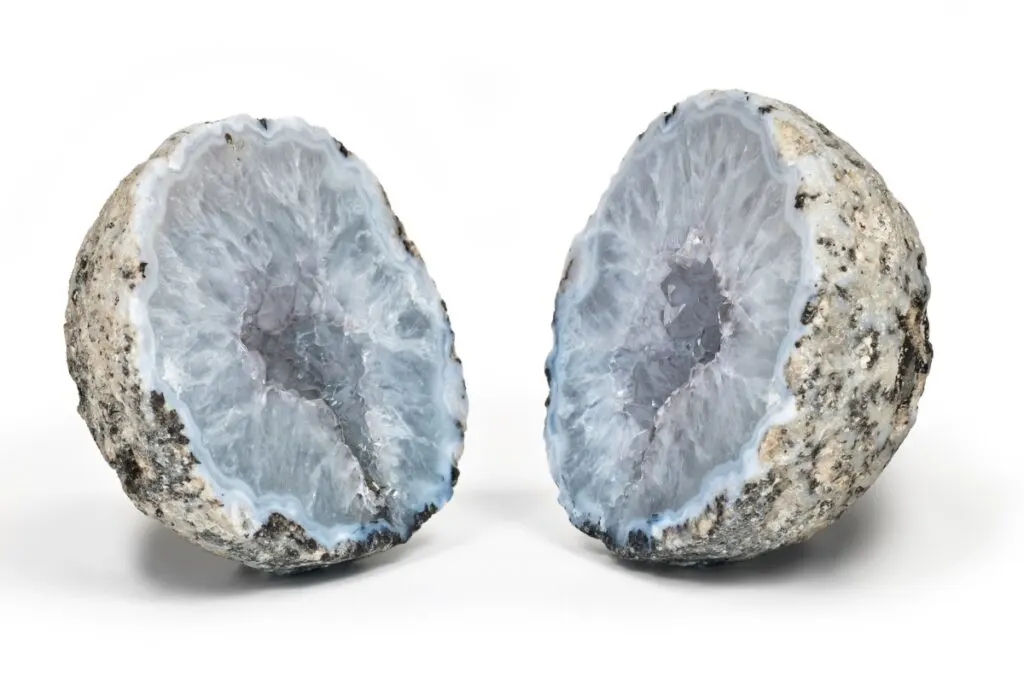
| Location | GPS Coordinates |
|---|---|
| Keokuk | 40.434395, -91.391363 |
| Farmington | 40.639182, -91.744031 |
| Bentonsport | 40.724511, -91.851463 |
| Donnellson | 40.637748, -91.561129 |
| Lowell | 40.832718, -91.436801 |
| Burlington | 40.829281, -91.101441 |
Did you know that the famous Keokuk geodes can contain 17 different types of minerals? The most common mineral found inside Keokuk geodes is quartz, but calcite is a close second.
These geodes tend to be on the larger side, with an average of 3.4 inches across and a maximum of over two feet. Both private collectors and museums around the world seek out Keokuk geodes due to their mineral inclusions and gorgeous crystal groups.
While it’s true that rockhounds find geodes all over the United States, the Keokuk area is known for its abundance and outstanding variety.
As you would expect, Keokuk is the best place to find Keokuk geodes; however, there are plenty of geodes scattered throughout this state, so there’s no need to despair if you can’t stop by Keokuk. Rockhounds also find all kinds of geodes near Burlington, Farmington, and Bentonsport.
Agate

| Location | GPS Coordinates |
|---|---|
| Burlington | 40.794591, -91.095776 |
| Skunk River | 40.949792, -91.621760 |
| Muscatine | 41.400161, -91.060655 |
| Keota | 41.362410, -91.956180 |
| Black Hawk County | 42.403183, -92.226303 |
| Bremer County | 42.762900, -92.386090 |
| Shell Rock | 42.710399, -92.578717 |
Any rockhound who’s a fan of Coldwater Agates will be happy to know that Iowa has plenty of these colorful rocks! Coldwater Agates are believed to be a sub-variety of Lake Superior agates, and Iowa’s Coldwater Agates display lavender, pale grey, and white lace patterns.
In addition to Coldwater Agates, rockhounds can uncover Lake Superior Agates, Banded Agates, Moss Agates, Oolitic Agates, and Sagenitic Agates.
To bring home agates from Iowa, explore the areas near Burlington, Bremer County, Black Hawk County, and Keota. The Skunk River is also a great location to pick up agates and other types of rocks.
Recommendation box: All tools and equipment you need for rockhounding and rock identification* (Amazon links):
1. Estwing Rock Hammer – Light, comfortable, and extremely durable hammer.
2. Estwing Geologist Pick – Classic and the most trusted paleo pick in the world.
3. Finder 12-inch Chisels – Heavy-duty chisels set with hand protection.
4. Mini Handle Shovel – This is a great tool for digging deep in the dirt.
5 Ironclad Utility Work Gloves – Breathable, but they also protect the areas requiring them most.
6. 3M Safety Glasses – Comfortable and efficient goggles for rockhounding.
7. Convoy 8+ UV Light – 365nm UV LED flashlight with a patented glass filter.
8. Wesley’s Jewelers Loupe – High magnification options (30X and 60X) with carrying case.
9. Mohs Hardness Kit – A specially designed kit for rockhounds
*All recommended products are personally tested and regularly used by experts from this website.
Jasper
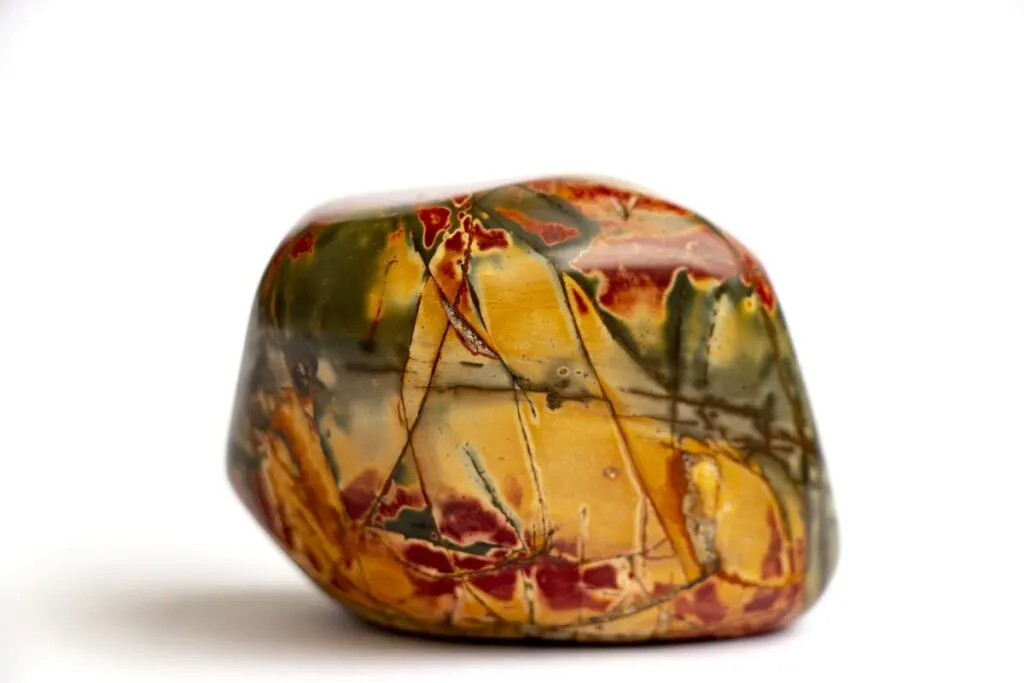
| Location | GPS Coordinates |
|---|---|
| Guttenberg | 42.795693, -91.101019 |
| Emmetsburg | 43.123502, -94.670670 |
| Graettinger | 43.233196, -94.744830 |
| Dubuque | 42.524994, -90.647964 |
| Bellevue | 42.268487, -90.427087 |
| New London | 40.930142, -91.408360 |
| Jackson County | 42.227732, -90.416586 |
Jasper can display all sorts of colors, and in Iowa, you’re most likely to find red jasper with bands of other colors running through it. The jasper from Iowa is high quality, so it’s a popular choice for tumbling and jewelry.
All the lakes, rivers, and streams near Guttenberg, New London, Emmetsburg, and Dubuque are known for their lovely pieces of red jasper, so be sure to add these locations to your rockhounding itinerary.
Chert
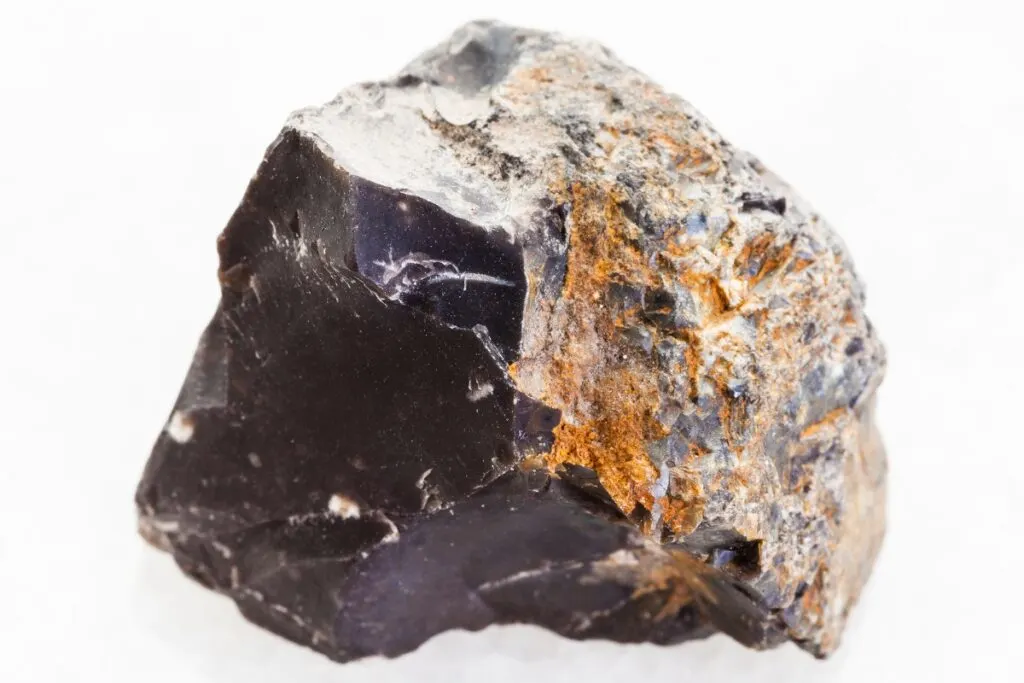
| Location | GPS Coordinates |
|---|---|
| Red Oak | 41.011187, -95.212072 |
| Dubuque | 42.542498, -90.655875 |
| Mount Pleasant | 40.970873, -91.560142 |
| Emmetsburg | 43.118992, -94.674361 |
| Black Hawk County | 42.499445, -92.410324 |
| Buchanan County | 42.478682, -91.929668 |
Black, grey, white, and red chert exist all over Iowa, and many pieces are considered to be gem-quality. Once polished, gem-quality pieces of Iowa chert display high shine and rich color, especially the darker shades such as black or red.
Almost every river and stream in Iowa contains chert, but some of the high-quality pieces are often discovered near Mount Pleasant, Black Hawk County, and Buchanan County.
TIP: Chert is one of the best-known sedimentary rocks, appearing in a variety of hues and shapes. Find out the guide on the best locations to find chert in the United States:
Where to Find Chert: Best Environments & Locations (USA)
Fossilized Coral
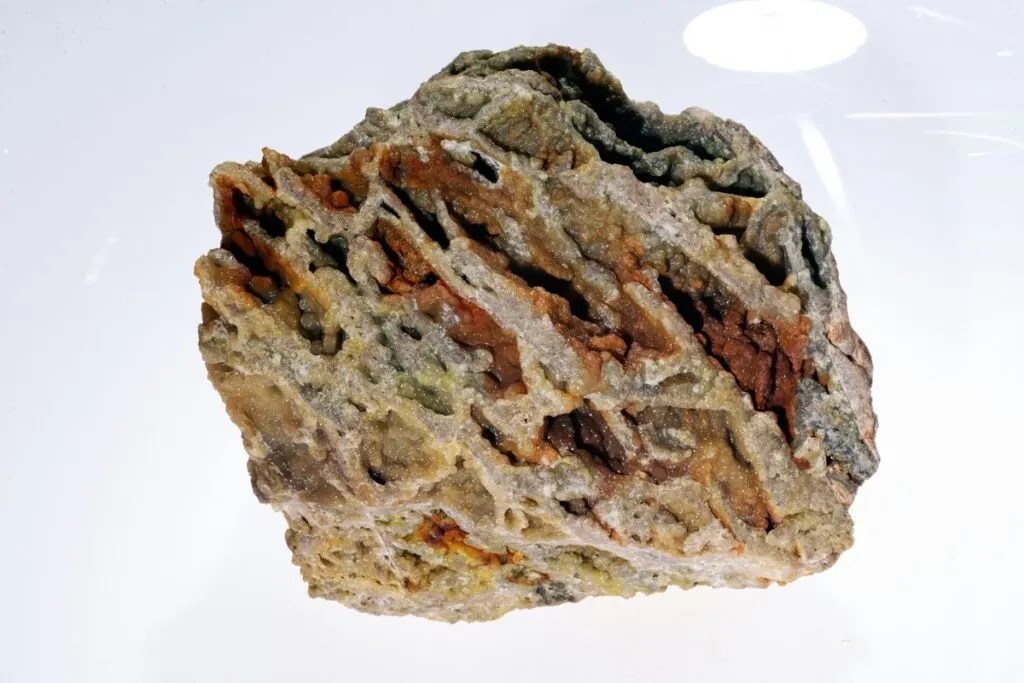
| Location | GPS Coordinates |
|---|---|
| Fremont County | 40.768055, -95.589945 |
| Rockford | 43.054736, -92.947805 |
| Buchanan County | 42.492860, -91.879543 |
| Coralville | 41.699152, -91.574172 |
| Keokuk | 40.415989, -91.382947 |
| Winnebago River | 43.213383, -93.287406 |
Since Iowa was once submerged under the sea, it makes sense that rockhounds can find all kinds of fossils in this state. One of the most popular finds is fossilized coral, an ancient rock that’s over 300 million years old!
Iowa’s fossilized coral is known for its near-perfect state of preservation, meaning the rock has retained the shape of the original organism.
Rockhounds find all shapes and sizes of fossilized coral in Iowa; some are the size of a pinky finger, while others are much larger and require two hands to hold.
Some places in Iowa where fossilized coral is particularly abundant are Fremont County, Buchanan County, and Rockford. In addition, the Winnebago River has plenty of fossilized coral and other rocks, so it’s definitely worth a visit.
What Minerals Are Found in Iowa
There are all kinds of shiny, colorful, and interesting minerals for rockhounds to collect in Iowa, including:
Chalcedony
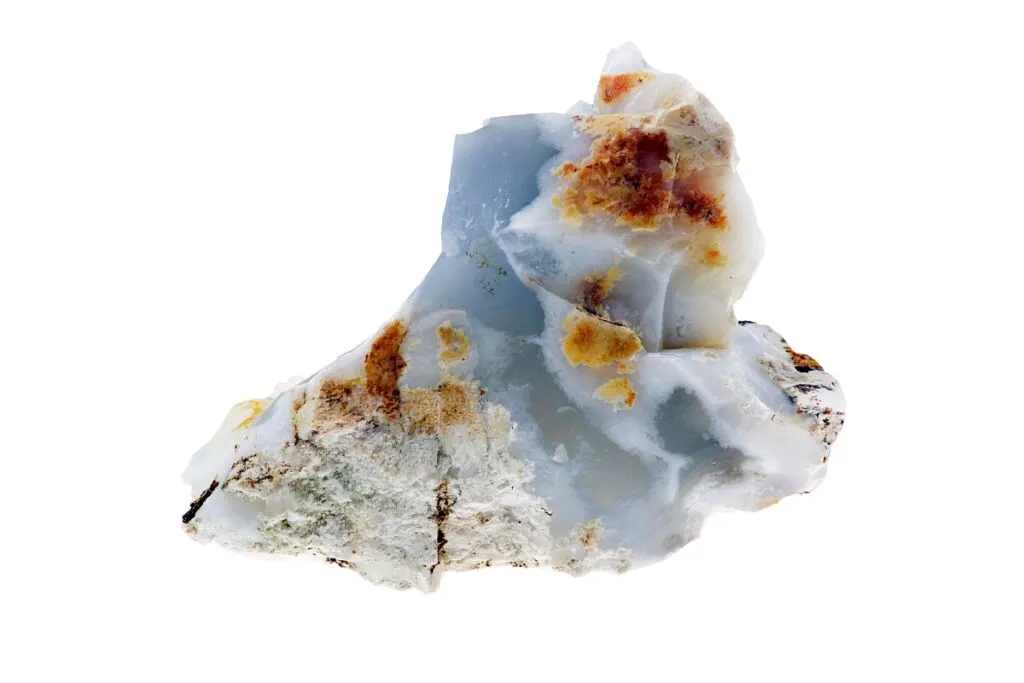
| Location | GPS Coordinates |
|---|---|
| Ames | 42.016014, -93.595650 |
| Keokuk | 40.415989, -91.382947 |
| Muscatine | 41.398100, -91.058767 |
| Des Moines County | 41.574089, -93.569783 |
| Bellevue | 42.263692, -90.424812 |
| Dubuque | 42.542498, -90.655875 |
White, grey, and blue chalcedony is prevalent anywhere you look in Iowa, and it’s often present in Iowa’s geodes. This shiny, slightly transparent mineral is frequently found in Iowa’s riverbanks or any gravel beds that are near water.
Ames, Keokuk, and Muscatine are excellent locations for chalcedony, especially if you are searching for geodes with this mineral.
Selenite
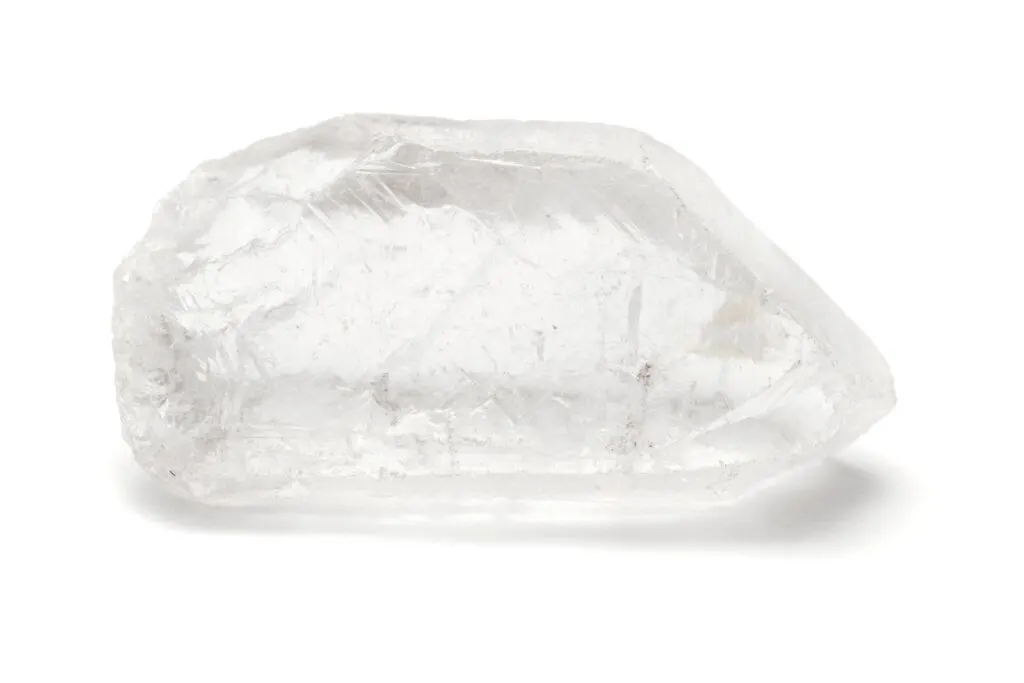
| Location | GPS Coordinates |
|---|---|
| Polk County | 41.690451, -93.547388 |
| Centerville | 40.717758, -92.881032 |
| Madison County | 41.326889, -93.989376 |
| Dallas County | 41.825553, -93.844752 |
| Marion County | 41.366946, -93.005134 |
| Plymouth County | 42.755942, -96.167352 |
Selenite is a form of gypsum, and it’s a popular mineral for rockhounds to collect. Usually, these minerals form long, transparent crystals, but in Iowa, these crystals have unique patterns. Iowa selenite displays black webs that form strange patterns in the crystals.
These black webs are just sand or dirt that became trapped in the crystal rather than another type of mineral or rock, but they still make Iowa’s selenite more visually appealing.
Polk County, Madison County, Dallas County, and Marion County are all known for their black and white pieces of selenite, but you can also search near Plymouth County and Centerville.
TIP: A very simple hardness test will allow you to tell if selenite is real or fake. Check out the complete guide on spotting fake selenite in the article below:
Real vs. Fake Selenite: Focus on These 5 Differences
Calcite
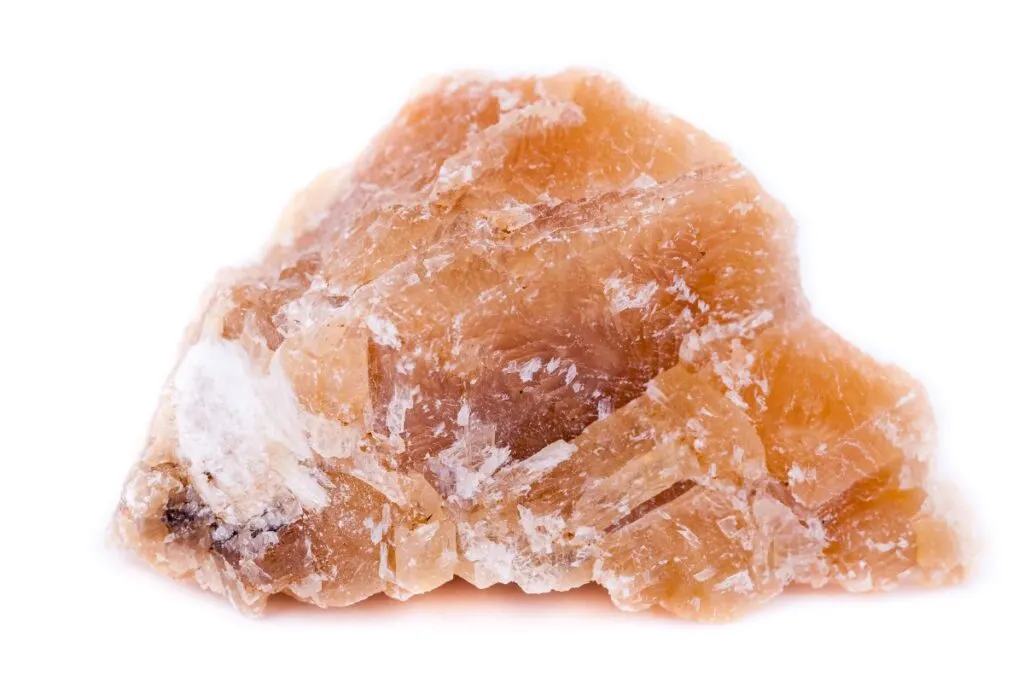
| Location | GPS Coordinates |
|---|---|
| Marion County | 41.366946, -93.005134 |
| Mahaska County | 41.319197, -92.612632 |
| Scott County | 41.575429, -90.433238 |
| Bells Mill Park | 42.340777, -93.891542 |
| Pershing | 41.262925, -93.006056 |
| Keokuk | 40.415989, -91.382947 |
Calcite is a common mineral that’s found all over the world. However, there are some unique variations that rockhounds collect from Iowa, including Dogtooth Spar, Iceland Spar, and black calcite.
Dogtooth Spars are calcite crystals that grow in a scalenohedral form, which resembles canine teeth. Iceland Spars are completely transparent pieces of calcite that resemble ice or glass, and as you may have guessed, they were originally found in Iceland.
In addition to these two special types of calcites, you might find black calcite, which stands out in any rockhound’s collection.
Clearly, Iowa is the place to go for all kinds of calcite! Check out Bells Mill Park for black calcite, or stop by Marion and Mahaska County for Dogtooth Spar and Iceland Spar. If you want to collect calcite geodes, Keokuk is your best bet.
Limonite
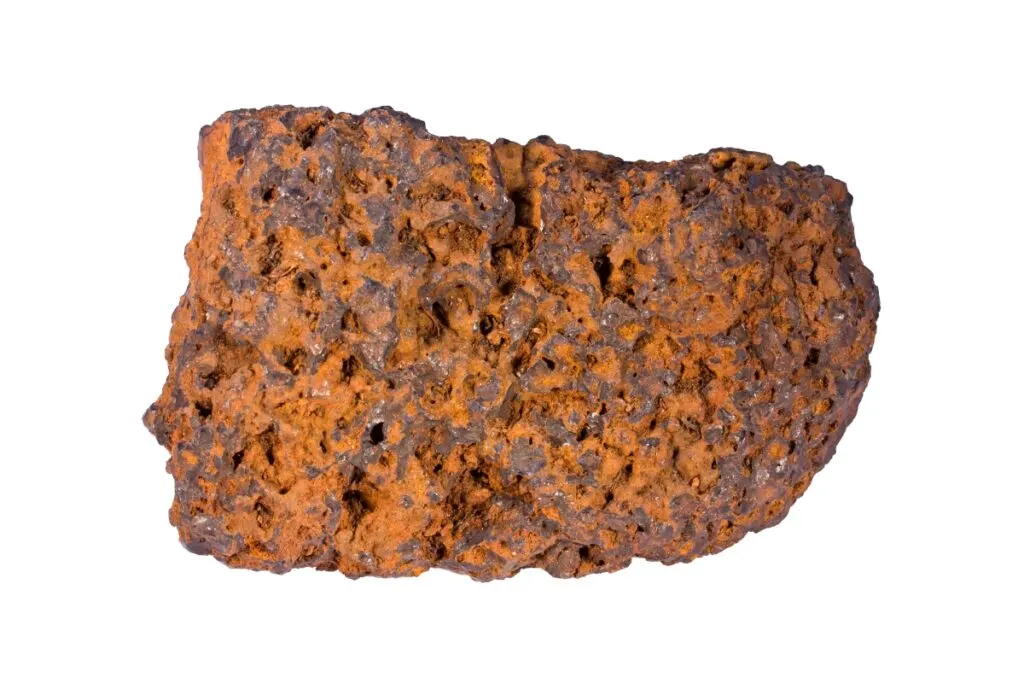
| Location | GPS Coordinates |
|---|---|
| Dubuque | 42.541993, -90.654845 |
| Henry County | 40.981219, -91.576142 |
| Clayton County | 42.876462, -91.146993 |
| Skunk River | 40.953517, -91.625498 |
| Keokuk | 40.416773, -91.383634 |
| Waukon | 43.261987, -91.477029 |
| Coburg | 40.915414, -95.264239 |
Limonite is a yellowish-brown mineral that’s an ore of iron, and it’s everywhere in Iowa. Interestingly, limonite comes in multiple shapes, including beds, concretions, and nodules. Sometimes, lucky rockhounds will find limonite mixed with other minerals, such as smokey quartz.
Henry County, Clayton County, and Dubuque are all known for their limonite. To add limonite geodes to their collections, rockhounds flock to Keokuk.
Pyrite
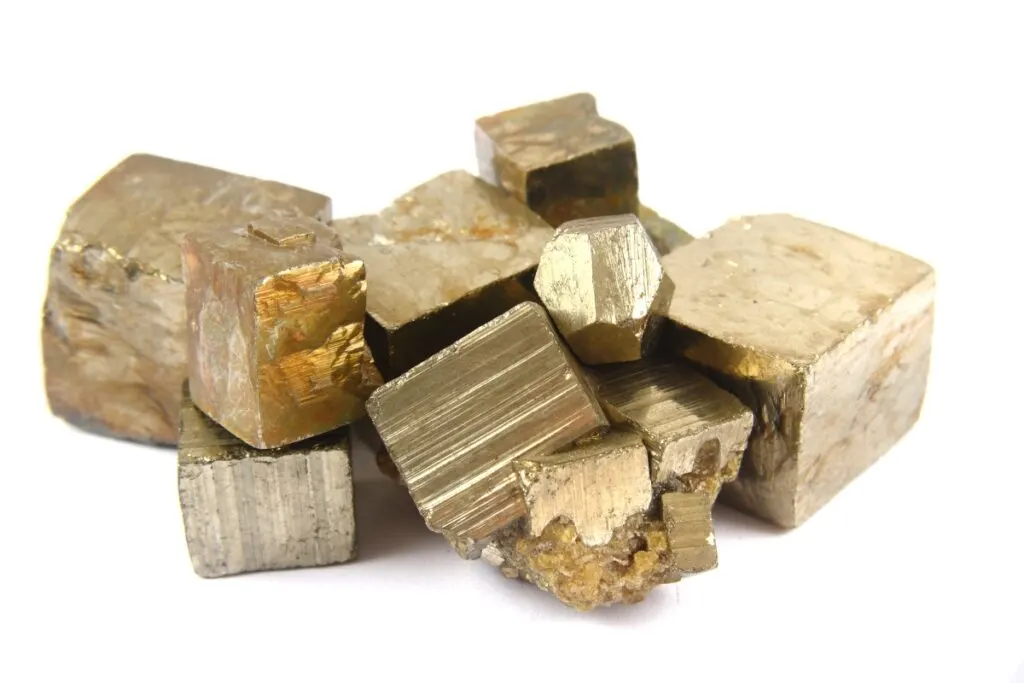
| Location | GPS Coordinates |
|---|---|
| Dubuque | 42.541993, -90.654845 |
| Black Hawk County | 42.499445, -92.410324 |
| Clayton County | 42.890550, -91.146990 |
| Centerville | 40.715677, -92.881032 |
| Keokuk | 40.415989, -91.382947 |
| Volga River | 42.754235, -91.367336 |
Although there are small amounts of gold in Iowa, rockhounds usually return home with pyrite, or Fool’s Gold. One mineral that’s very similar to pyrite is marcasite, and it’s also a common mineral in Iowa.
The main difference between pyrite and marcasite is their crystal formation; pyrite has an isometric crystal formation, while marcasite has an orthorhombic crystal formation. Another difference is their color. Iowa pyrite has a yellowish hue, while marcasite tends to be greenish in color.
To find pyrite or marcasite in the Hoosier State, visit Black Hawk County, Clayton County, and Dubuque. For pyrite geodes, the Keokuk area is the best place to visit.
Quartz
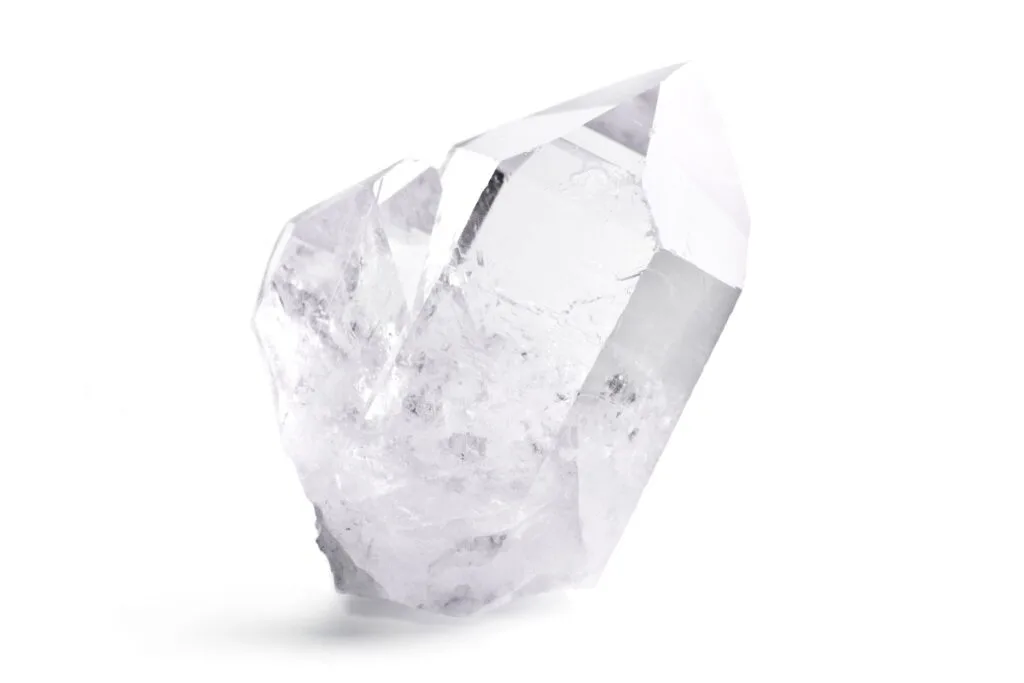
| Location | GPS Coordinates |
|---|---|
| Keokuk | 40.415989, -91.382947 |
| Orient | 41.205997, -94.418542 |
| Steamboat Rock | 42.408935, -93.072007 |
| Muscatine | 41.398615, -91.060140 |
| Burlington | 40.791992, -91.095947 |
| Farmington | 40.639866, -91.744160 |
| Mount Pleasant | 40.958235, -91.531045 |
Both quartz geodes and individual crystals are scattered all over Iowa, so many rockhounds return home with this shiny mineral.
Clear quartz is the most common, but some rockhounds also collect amethyst and smokey quartz from certain areas. While individual quartz crystals are beautiful, most rockhounds visit Iowa for their geodes and end up finding this mineral inside the rocks.
While Keokuk is famous for its quartz geodes, rockhounds also frequent Orient, Steamboat Rock, Burlington, and Muscatine for this popular mineral.
TIP: Quartz is a hard, crystalline mineral composed of two oxygen and one silicone atom. It takes years to form this mineral under extreme pressure. Find out more in the article below:
Forming of Quartz Crystals & Its Varietes Explained by PRO
FAQ About Common Rocks & Minerals in Iowa
While Iowa is famous for its geodes, there are plenty of other rocks and minerals for rockhounds to find, including:
What Rare Rocks Can You Find in Iowa
In addition to world-famous geodes, Iowa is home to many other rare rocks, such as agate, jasper, fossilized coral, and petrified wood. Iowa is one of the few places in the U.S. where rockhounds are able to collect Lake Superior Agates and Coldwater Agates.
The Lake Superior Agates from Iowa are known for their vibrant red and orange coloring, while Iowa’s Coldwater Agates display paler colors of purple, white, and grey.
Two other rocks that are popular among collectors are Iowa’s fossilized coral and petrified wood. In the Hoosier State, fossilized coral retains the exact shape of the original organism, and many pieces are over 300 million years old.
Even though there aren’t any petrified forests in Iowa, there are pieces of petrified wood in the rivers and streams. Millions of years ago, glacial drift brought petrified wood and many other foreign rocks, such as igneous rocks, into Iowa, and these special stones are often discovered in gravel beds or waterways.
All these rare rocks and more can be found in Jackson County, Black Hawk County, Dubuque, Burlington, and Keokuk. The rivers, creeks, and gravel beds in these areas are some of the best sites to find rocks in the Hoosier State.
BTW: Do you want to know more about rock and mineral identification? The books listed below are the best ones you can find on the internet (Amazon links):
- Smithsonian Handbooks: Rocks & Minerals
- Gemstone & Crystal Properties (Quick Study Home)
- Ultimate Explorer Field Guide: Rocks and Minerals (National Geographic Kids)
What Rare Minerals Can You Find in Iowa
Every rockhound wants to get their hands on some rare minerals, and there are more than enough to go around in Iowa.
Moonstone, carnelian, sapphire, diamond, amethyst, aragonite, onyx, black calcite, chalcedony, pearls, sphalerite, garnet, and fluorite all exist in Iowa, though some are rarer finds than others.
While gold has been discovered in this state, it’s only in small amounts, and rockhounds are much more likely to find pyrite than its valuable twin.
Marion County, Muscatine, Dubuque, and Burlington are excellent places to find all sorts of rare minerals. The Skunk River and Winnebago River are also excellent sites for rockhounds.
What is the Most Famous Rock or Mineral Found in Iowa
Did you know that Iowa geodes contain some of the most beautiful crystals to be found anywhere in the Midwest?
These geodes can contain over 17 different minerals, a large variety that’s rarely found in other areas of the U.S. Over time, Iowa’s geodes became so popular that they brought in tourists from around the world, and to keep this flow of tourism, Iowa nominated the geode as its state rock in 1967.
Although geodes have been discovered in multiple areas of Iowa, the ones found near Keokuk outshine all the rest. Every visiting rockhound should stop by Keokuk at least once to see these spectacular geodes for themselves!
Conclusion
From geodes to limonite, there are all kinds of rocks and minerals that make Iowa an exceptional place for rockhounds.
With places like Keokuk and Burlington that are overflowing with colorful rocks and glittering minerals, Iowa is an excellent state for any rockhound who wants to grow their collection. Pick up a couple Keokuk geodes during your travels, or maybe take some time to collect a few Coldwater Agates.
Whatever you want to find during your rockhounding adventures, Iowa is sure to have everything you’re looking for and more!
TIP: Though Iowa is not one of the most famous states for rockhounding, there are still some very interesting places to explore. Check out the complete guide below:
Where to Rockhound in Iowa (and What You Can Find)
